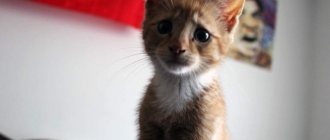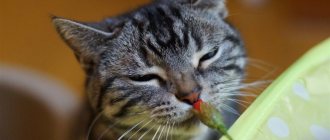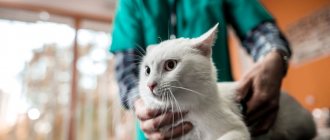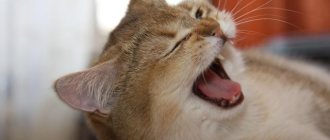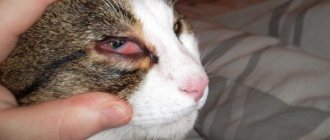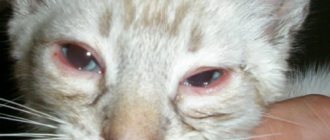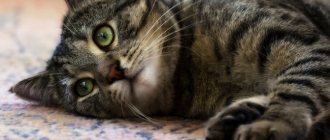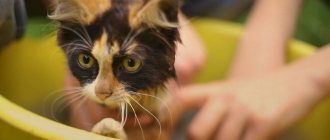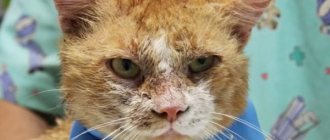A runny nose in cats is a fairly common phenomenon. Unlike people, colds in cats are not always easy and without consequences. Therefore, if you discover rhinitis in your pet, you should immediately contact a veterinarian for prompt treatment.
The main causes of runny nose in cats are a number of phenomena:
- hypothermia is the main cause of rhinitis in cats. Despite the presence of fur and the general belief that cats are the most tenacious creatures, they do not like drafts and long stays in cold air, as well as damp rooms;
- infectious diseases, colds, viruses;
- the cat’s reaction to household chemicals, perfumes, cigarette smoke and other mucosal irritants;
- the use of drugs that affect the condition of the mucous membrane;
- fungi, bacteria;
- the presence of indolent diseases not directly related to the nose;
- polyps, tumors;
- ear infection;
- contact with the nasal mucosa of a foreign body;
- congenital pathologies;
- worms, helminths, other parasites.
Memo for the owner: what to look for
Rhinitis in cats, or an inflammatory process in the nasal passages, develops as a response to the influence of external factors on the nasal mucosa. The glands begin to intensively produce a protective secretion, a mucous liquid (runny nose, snot). When a secondary infection occurs, the serous-mucosal discharge becomes purulent.
Why does snot appear?
Nasal discharge occurs due to:
- Colds. When the body is hypothermic, walking in damp rooms with drafts, feeding cold foods.
- Allergies. Strong odors, fragrances, cigarette smoke, reactions to medications, parasite medications, etc.
- Foreign bodies
- Fungi, viruses, bacteria (rhinotracheitis, panleukopenia, mycoplasmosis, calicivirosis, pneumonia).
- Parasitic infections.
A runny nose as a symptom manifests itself when there is inflammation of the ears, congenital anomalies of the nasal septum, neoplasms, or when a cat’s nose is exposed to cold and hot air.
The breeder must pay attention to the presence of discharge from the nasal passages (snot) of varying consistency. A runny nose almost always goes away with lacrimation; the nasal passages are connected to the lacrimal canals. There is difficulty breathing, the nasal mucosa swells, the cat sniffles, sneezes, and rubs its face with its paws.
General symptoms of illness: apathy, anorexia, hyperthermia, lethargy.
Causes of the disease
Causes of runny nose:
- hypothermia of the kitten, for example, as a result of walking in the cold, playing or sleeping in a draft;
- eating cold food or cold drink;
- allergic reaction: perhaps a new product has been included in the diet or the body has reacted with a runny nose, redness, lacrimation to dust, indoor plants, perfume aromas;
- a weakened immune system poorly resists infections, fungi, bacteria, and any infectious disease can insidiously manifest itself in the first days as a runny nose and other cold symptoms;
- due to the curiosity and playfulness of the kitten, a foreign object could be in the nose, causing the formation of mucus as a reaction to irritation;
- formation of tumors, polyps in the nasal passages;
- parasites (worms);
- strong odors that can cause sneezing and mucus from the nose;
- inflammation of the ear that spreads to the nasopharynx;
- congenital pathology of the nasopharynx (deviated nasal septum);
- chronic diseases passed on from the mother.
Runny nose in cats: main causes
Correct diagnosis is an integral part of therapy; it will not be successful without determining the cause of the runny nose. The symptom accompanies the following pathological conditions:
- Infectious diseases.
A runny nose will occur with viral rhinotracheitis (herpervirus), calicivirus infection. The diseases are seasonal, with frequent exacerbations occurring in spring and autumn. The source of infection is sick animals, virus carriers. The first symptoms of illness appear after 2-10 days, depending on the disease, immunity, age of the cat and concomitant pathologies.
The cat has a runny nose and watery eyes. There is a bilateral discharge from the nose, initially of a serous-mucous nature, then the exudate thickens, becomes purulent, and discharge from the eyes appears. The animal is apathetic, refuses to eat, has an elevated temperature, and is sneezing. If left untreated, the oral mucosa and conjunctiva ulcerate.
The diagnosis is made based on symptoms (runny nose, sneezing), laboratory tests (PCR, serological tests). The treatment is long-term, immunoglobulins, broad-spectrum antibiotics, immunomodulators, and vitamins are prescribed. The nose, mouth and eyes are washed with antiseptic solutions, and cold drops for cats are used to make breathing easier.
The development of calicivirus infection and viral rhinotracheitis can be prevented with timely vaccination.
- Bacterial infections.
A runny nose in cats occurs with mycoplasmosis, chlamydia, and bordetellosis. Chronic runny nose (rhinitis) in a cat and sinusitis develop after viral infections or deformation of the sinuses. Typical symptoms: unilateral or bilateral nasal discharge, sneezing, conjunctivitis (severe in chlamydia), cough (bordetellosis).
Treatment is complex, immunomodulators and antibiotics are prescribed. For bordetellosis, fluoroquinol drugs are effective; for mycoplasmosis and chlamydia, macrolides and tetracyclines are effective.
Mycoplasmosis, chlamydia (opportunistic microflora) are prevented by good nutrition, keeping the animal, and timely treatment of pathologies leading to chlamydial immunosuppression.
Bordetellosis in cats, or “kennel cough,” spreads quickly when animals are kept in crowded conditions without sanitary standards. It is characterized by sinusitis, chronic rhinitis, bilateral, purulent nasal discharge, respiratory failure, and sneezing. The general condition of the animal with bordetellosis is satisfactory, there is no appetite.
- Neoplasms.
Tumors of a benign and malignant nature form in the nasal cavity. Nasopharyngeal polyps, adenocarcinoma, lymphosarcoma, osteo- and fibrosarcoma are diagnosed. With benign neoplasms (polyps), a runny nose of a mucopurulent nature, breathing and swallowing are difficult, the cat sneezes. Treatment – removal of polyps, prevention of their appearance through timely treatment of inflammatory processes in the upper respiratory tract.
In the case of malignant formations, the nature of nasal discharge changes, the discharge is one or bilateral, initially mucous, changing to purulent and hemorrhagic. There is swelling of the muzzle and deformation of the sinuses. The treatment is complex, chemotherapy, surgery, combined treatment are prescribed, it all depends on the histotype of the tumor, the complexity of the pathological process, and the age of the cat.
- Injuries.
Cats have a runny nose when struck, resulting in a cleft palate (fall from a height) and the development of chronic rhinitis. Often the symptom is a runny nose, this is the result of injury to the nasal cavity by a foreign object.
With a cleft palate, nasal discharge is bilateral, mixed with food. Treatment is surgery, surgical plastic surgery is performed to eliminate the cleft. The discharge is serous, mucous, then purulent due to a foreign body in the nose. Treatment is removal of foreign inclusions, antibiotic therapy and prevention of the development of secondary infection.
- Mycoses.
Fungal infections are rarely diagnosed in cats; an example is cryptococcosis. The disease is characterized by unilateral or bilateral runny nose, deformation of the facial part of the skull. During treatment, systemic antimycotic agents are prescribed that are active against yeast-like fungi. Mycoses often accompany diseases that provoke immunodeficiency in cats - viral leukemia, viral immunodeficiency.
How to treat cat colds
0
0
Although our cats walk on their own, occasionally delighting us with their attention, in society they behave almost like children: when they want to tell us something, it’s difficult to guess what exactly they want. If cats could talk, we would definitely be the first to know that something hurts them and how we can help them. But in the absence of our usual communication, we need to be careful and observe the cat’s behavior, which may directly or indirectly indicate some health problems.
About the cat's nose and runny nose
As you know, a wet and cold nose is an indicator of a cat’s health. A thin layer of mucus on a cat's nose allows it to better recognize odors and, accordingly, hunt. When a cat is unwell, its nose becomes dry and does not recognize odors well, and its appetite decreases during this period. In addition, a wet nose is also a biological filter that prevents microorganisms and dust from entering. If a cat is sick (or if she is dehydrated), the nasal mucosa becomes dry and allows bacteria into the respiratory system.
A cat's runny nose is similar in all respects to a human one, but it is not at all the same thing. A runny nose can be caused by infection, hypothermia, or due to a foreign body or parasites entering the nose of an animal. When you have a runny nose, the glands in the nasal cavity, trying to get rid of irritation, begin to produce mucus. The mucous membrane of the nose swells, the nasal passages narrow, due to which the inhaled air is not warmed up and purified, and in general breathing becomes difficult.
Symptoms of the disease:
- hot dry nose and hot ears;
- weakness, apathy;
- sneezing, coughing or snorting;
- fever, discharge from the eyes and nose;
- decreased appetite or lack thereof.
Cat cold
Although animals have their own naturally warm coats, cold weather can be dangerous for indoor cats. If we go outside in a coat, after a while we still feel cold and damp, and if we stay in this state for a long time, we can easily get sick. Likewise, our pets - in the cold season, can get sick just like their owners, with the only difference being that human colds are not transmitted to cats, and feline colds are not transmitted to people.
If your cat walks outside, then in cold weather she is at risk of getting sick. In late autumn and especially in winter, you should still refrain from such walks. However, even at home you can catch a cold, for example, due to a draft. Short-haired cats and cats without fur - Sphynx cats - are especially susceptible to this risk. The latter generally require more careful care: they cannot stand the cold and even due to a barely perceptible draft they can catch a cold. The temperature in the apartment should be comfortable, and, of course, you should not leave the balcony open or constantly ventilate the room.
What is not recommended in the cold season and off-season
1. If your cat is out and about, make sure it has returned home. And in winter it is generally better to refrain from walking.
2. You should also refrain from bathing your pet. Even if you have bathed your cat, monitor the temperature in the house and drafts, not to mention open balconies.
3. If you ventilate the room, check afterwards to see if you locked your cat on the balcony. No matter how strange it may sound to many readers, some owners inadvertently close the balcony without noticing that the cat has jumped out to get some fresh air.
If your cat rubs its nose with its paw, sneezes and snorts sporadically, it is probably trying to get rid of a foreign body in its nose. Usually cats quickly cope with this on their own, but if you notice that your cat continues to sneeze, contact your veterinarian immediately.
Allergic reactions
A runny nose can also occur due to allergic reactions of the cat's body to specific chemicals that irritate the nasal mucosa. For example, this is not at all surprising if you used ammonia, acid, alkalis and other chemicals in the presence of a cat. You should be careful when cleaning your apartment, because there are plenty of dangers in the house: in the kitchen, in the bathroom, and in the toilet. Dishwashing, bath, toilet detergents, washing powders, sprays and powders against insects, etc. You should be especially careful when cleaning the bathroom and toilet: for some reason cats really like to hide under the bathtub while you are cleaning it . Be sure to check if the cat was accidentally left closed there while cleaning.
Don't forget about the little things either. Even dirt brought into the house on shoes can pose a danger to your pet - the streets are usually sprinkled with reagents that are unlikely to have a beneficial effect on the health of both the cat and the children and adults in the house. Infections and viral diseases
Only vaccinations can protect a cat from dangerous infections. Vaccination is carried out for a kitten at the age of 8-9 weeks, secondary vaccination - 11-12 weeks, subsequent vaccinations - annually.
If you notice that your cat has begun to sneeze or cough, be sure to contact your veterinarian as soon as possible. But even here we should not forget about important little things. When planning a trip to the clinic, many people forget about trivial things: for example, taking a sick pet on public transport, which is strongly not recommended. It is better to go by car (even if you have to call a taxi) or, if possible, call a veterinarian at home.
Only a veterinarian can help with illness - he will be the one who can determine what the cat is sick with and how to treat it. There should be no place for “self-medication” here.
“In principle, cats (and people) do not have a disease called “cold.” As a rule, this word is popularly used to describe a viral infection that affects the respiratory system.
People usually get sick from it easily, but cats, on the contrary, if they get a viral infection and do not receive help in time, they can die. Because their owners associate it with something similar to a cold in people and do not rush to see a doctor.
To reduce respiratory diseases in cats, all healthy cats must be vaccinated annually against the most common infectious diseases, such as rhinotracheitis, calicivirosis and panleukopenia. These viral diseases of cats are not dangerous to people. Cats are not at risk from viruses that cause human respiratory diseases, such as influenza.”
Found a mistake? You can report an error by highlighting it and pressing Ctrl+Enter
What to do if your cat has a runny nose?
The smartest thing to do is take the cat to a veterinary clinic or call a doctor at home. Self-treatment will not be effective without a diagnosis, and in the case of infections, a common runny nose can be fatal.
A runny nose in cats is not contagious to humans, but when in contact with a pet, especially when washing the nasal passages with your own hands, you must follow simple hygiene rules.
How to rinse a cat's nose? The following solutions are effective:
- Saline solution (9%).
- Saline (1 tsp salt per 1 liter of water).
- Boric acid (2-3%).
- Zinc sulfate (0.5-1%).
- Furacillin (tablet per glass).
- Dioxidine (0.5%, buy 1% solution at the pharmacy and dilute twice).
- Soda (1\2 tsp soda per 0.5 l of water).
The order of application of the solution, frequency of use and for what pathologies is decided by the doctor.
The cat is secured by wrapping it tightly in a towel, leaving only its head outside. Place a solution (0.5 ml) into a syringe without a needle and carefully pour it into the nostril. Do not press the piston too hard; remove the leaking liquid with napkins. When you sneeze and snort, deeply localized mucus will come out.
General strengthening treatment is necessary to strengthen the cat’s immunity and help it cope with the underlying disease. Gamavit (0.3-0.5 ml/kg), Fosprenil, Immunofan, Ribotan are prescribed.
It is necessary to cure a runny nose in a cat; this is a symptom that should not be ignored and expect that it will go away on its own without consequences for the animal’s health.
How is rhinitis treated in cats?
Treatment directly depends on the root cause of the runny nose. If it occurs against the background of a cold, then the doctor prescribes special medications, nasal drops and antiviral immunostimulating agents to eliminate colds. If rhinitis is associated with some other disease, then first the doctor gets rid of this disease, and then the symptoms of a runny nose go away.
If you want the kitten to recover as quickly as possible, then you need to not only follow all the doctor’s recommendations, but also:
- provide your pet with a comfortable and warm place in the apartment;
— provide complete, balanced nutrition;
- surround him with love and care.
Remember that for a speedy recovery from rhinitis, the cat will need a lot of love and care from its owners.
Since the sense of smell is very important for cats, owners should immediately contact a veterinary clinic if they notice a runny nose, difficulty breathing or nasal discharge. Otherwise, the nose will not be able to perform important functions such as warming and purifying inhaled air, which can lead to hypothermia and a decrease in oxygen to the brain.
How and how to treat rhinitis in a cat should be decided exclusively by a veterinarian, who will conduct the necessary examinations and accurately determine the cause of the disease. “Murkosha” warns all owners that by self-medicating, using traditional methods and resorting to advice from the Internet, you will only harm your pet.
Symptoms of nasal congestion
How can you tell if your cat has a stuffy nose? Even if this symptom manifests itself before the appearance of profuse discharge from the nose and watery eyes, it is the first bell for the owner.
So, the signs of nasal congestion are as follows:
- the cat sniffles and sneezes;
- rubs the face with its paws, especially the nose;
- increased body temperature (rectally measured);
- the animal is lethargic;
- appetite is reduced.
These are the general signs with which respiratory infections all begin. Read more about the possible causes of illness in the article “The cat has a runny nose and is sneezing: how to treat?”
Prevention of rhinitis
The best protection against rhinitis is vaccination. While vaccines are the best defense against viral diseases, they are not 100% effective and the viruses that cause this condition are widespread.
- Vaccination of a cat before mating.
- Avoid exposing kittens to other cats until at least one week after the second vaccination.
- Frequent bedding changes (cat viruses are often spread through body fluids.
- Separate sick cats from healthy cats as soon as possible.
(c) Veterinary center for the treatment and rehabilitation of animals “Zoostatus”. Varshavskoe highway, 125 building 1. tel. 8 (499) 372-27-37
Diagnosis of rhinosinusitis
To make a diagnosis of chronic rhinosinusitis in cats, it is necessary to exclude other causes of diseases of the nasal cavity and sinuses.
The differential diagnosis for cats with acute, short-duration symptoms is different from that for cats with chronic, persistent, or recurrent symptoms.
Differential diagnoses for cats with chronic signs include nasal neoplasia (most commonly lymphoma and carcinoma). Fungal rhinitis (usually cryptococcosis). Periodontitis, nasopharyngeal polyps and foreign bodies in the nasal cavity.
Differential diagnoses for an acute process include all those mentioned above for cats with a chronic course of the disease, as well as herpesvirus, calicivirus, chlamydia, and bordetellosis.
Routine tests, such as complete clinical and biochemical blood tests, complete clinical urine analysis, and serological tests are useful in determining general health status, but do not contribute to the diagnosis of this clinical syndrome.
X-rays and computed tomography may not be very informative. Sometimes there is a change in the normal shape of the turbinates, and an accumulation of secretions in the sinuses.
Bacteriological culture of swabs can determine the bacterial microflora, but does not prove the leading role of microbial infection.
During rhinoscopy, either no changes are detected, or mucus and hyperemia are observed in the affected nasal passages. Sometimes during rhinoscopy, destruction or curvature of the nasal turbinates is visualized.
A biopsy may reveal neutrophilic or lymphoplasmacytic inflammation. This is most useful for differential diagnosis, including neoplasms.
